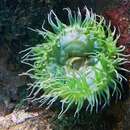en
names in breadcrumbs


Growth of individual anemones is often slow, while life spans are greatly extended. It has been found that A. xanthogrammica can live to an age of more than 80 years (Batchelder,1980; Mohler,et al.,1997).
US Federal List: no special status
CITES: no special status
This species provides no known adverse affects to humans.
Anthopleura xanthogrammica has been the source of several medical studies. Contained within its tissues, at low concentrations, is a cardiotonic agent that has been associated with favorable stimulatory effects when introduced to the vertebrate heart. Clinical studies have show that this agent is a good candidate in the treatment of a failing heart and has considerable advantages over currently used drugs. There is question as to whether harvesting naturally occuring populations of A. xanthogrammica and A. elegantissima is a feasible way to manufacture this stimulant (Batchelder,1980; Morris,et al.,1992).
The main food sources for A. xanthogrammica are mussels, sea urchins, small fish and crabs. These animals are paralyzed and captured after coming in contact with the anemones stinging tentacles. Once the prey are paralyzed, A. xanthogrammica pulls these animals into its mouth, contained in the center of its crown. When digestion is complete it excretes the waste through the same opening. The epidermis and tissues lining the gut of A. xanthogrammica contain living photosynthetic algae zoochlorellae, and the dinoflagelates zooxanthellae. These symbiotic protists can produce organic nutrients through photosynthesis that may also contribute to the nutritional needs of the anemone. It has been noted that anemones living in caves have reduced numbers of, or are completely lacking natural symbionts (Giant, 1998; Morris,et al.,1992).
Anthopleura xanthogrammica inhabits the low to mid intertidal zones of the Pacific Ocean, ranging continuously from Alaska to Point Conception. It also occurs in areas of cold upwellings possibly as south far as Panama (Smith and Potts,1987).
Biogeographic Regions: pacific ocean (Native )
Sand and rock covered shore lines are prime habitat for A. xanthogrammica. To prevent dessication due to extended periods of time with no water, these anemones will take up residence in the mid to low intertidal where they will be covered with water most of the day.
This species of anemone can grow to a column width of 17 cm and a height of 30 cm. The tentacular crown can grow to 25 cm in diameter with numerous tentacles arranged in six or more rows around the margin. The tentacles and column are green but can vary in intensity, ranging from light green in the tentacles to olive green in the column.
Stinging cells called cnidocytes are located within the tentacles. These cells help A. xanthogrammica paralyze its prey, but causes no harm to humans (Giant,1998; Morris,et al.,1992).
Other Physical Features: ectothermic ; radial symmetry
A. xanthogrammica reproduces sexually through external fertilization of sperm and eggs. Spawning generally occurs in the fall from September to November and will produce pelagic, planktotrophic larvae. These larvae float freely for a period of time until they become widely dispersed. Larvae tend to settle in established mussel beds where they will begin to develop (Smith and Potts,1987).
Parental Investment: no parental involvement